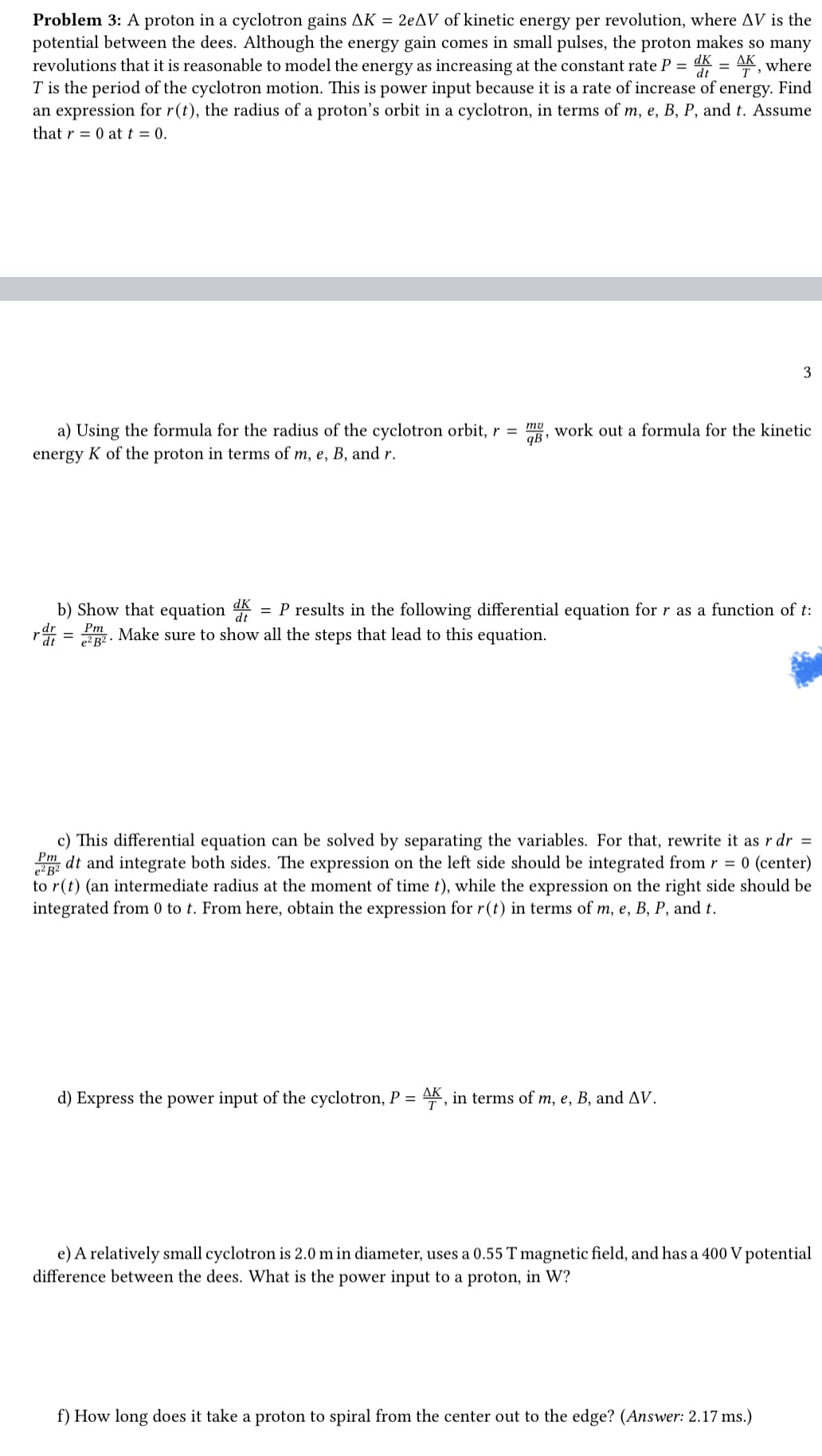T is the period of the cyclotron motion. This is power input because it is a rate of increase of energy. Find an expression for r(t), the radius of a proton's orbit in a cyclotron, in terms of m, e, B, P, and t. Assume that r= 0 at t = 0.
T is the period of the cyclotron motion. This is power input because it is a rate of increase of energy. Find an expression for r(t), the radius of a proton's orbit in a cyclotron, in terms of m, e, B, P, and t. Assume that r= 0 at t = 0.
Chapter11: Magnetic Forces And Fields
Section: Chapter Questions
Problem 55P: The magnetic field in a cyclotron is 1.25 T, and the maximum orbital radius of the circulating...
Related questions
Question
Hello, please I really need help with part D and part E I really don't understand understand those two problems I have done all of the other parts I just need help with that one, please I need help with part D and part E and can you label them

Transcribed Image Text:ΔΚ
Problem 3: A proton in a cyclotron gains AK = 2eAV of kinetic energy per revolution, where AV is the
potential between the dees. Although the energy gain comes in small pulses, the proton makes so many
revolutions that it is reasonable to model the energy as increasing at the constant rate P = K = AK, where
T is the period of the cyclotron motion. This is power input because it is a rate of increase of energy. Find
an expression for r(t), the radius of a proton's orbit in a cyclotron, in terms of m, e, B, P, and t. Assume
that r = 0 at t = 0.
a) Using the formula for the radius of the cyclotron orbit, r = mg, work out a formula for the kinetic
energy K of the proton in terms of m, e, B, and r.
b) Show that equation d dK = P results in the following differential equation for r as a function of t:
Make sure to show all the steps that lead to this equation.
rder t
=
Pm
e² B².
3
Pm
e²B²
c) This differential equation can be solved by separating the variables. For that, rewrite it as r dr =
dt and integrate both sides. The expression on the left side should be integrated from r = 0 (center)
to r(t) (an intermediate radius at the moment of time t), while the expression on the right side should be
integrated from 0 to t. From here, obtain the expression for r(t) in terms of m, e, B, P, and t.
d) Express the power input of the cyclotron, P = AK, in terms of m, e, B, and AV.
e) A relatively small cyclotron is 2.0 m in diameter, uses a 0.55 T magnetic field, and has a 400 V potential
difference between the dees. What is the power input to a proton, in W?
f) How long does it take a proton to spiral from the center out to the edge? (Answer: 2.17 ms.)
Expert Solution
This question has been solved!
Explore an expertly crafted, step-by-step solution for a thorough understanding of key concepts.
This is a popular solution!
Trending now
This is a popular solution!
Step by step
Solved in 5 steps with 5 images

Knowledge Booster
Learn more about
Need a deep-dive on the concept behind this application? Look no further. Learn more about this topic, physics and related others by exploring similar questions and additional content below.Recommended textbooks for you


University Physics Volume 3
Physics
ISBN:
9781938168185
Author:
William Moebs, Jeff Sanny
Publisher:
OpenStax

Physics for Scientists and Engineers, Technology …
Physics
ISBN:
9781305116399
Author:
Raymond A. Serway, John W. Jewett
Publisher:
Cengage Learning


University Physics Volume 3
Physics
ISBN:
9781938168185
Author:
William Moebs, Jeff Sanny
Publisher:
OpenStax

Physics for Scientists and Engineers, Technology …
Physics
ISBN:
9781305116399
Author:
Raymond A. Serway, John W. Jewett
Publisher:
Cengage Learning

Glencoe Physics: Principles and Problems, Student…
Physics
ISBN:
9780078807213
Author:
Paul W. Zitzewitz
Publisher:
Glencoe/McGraw-Hill

Modern Physics
Physics
ISBN:
9781111794378
Author:
Raymond A. Serway, Clement J. Moses, Curt A. Moyer
Publisher:
Cengage Learning